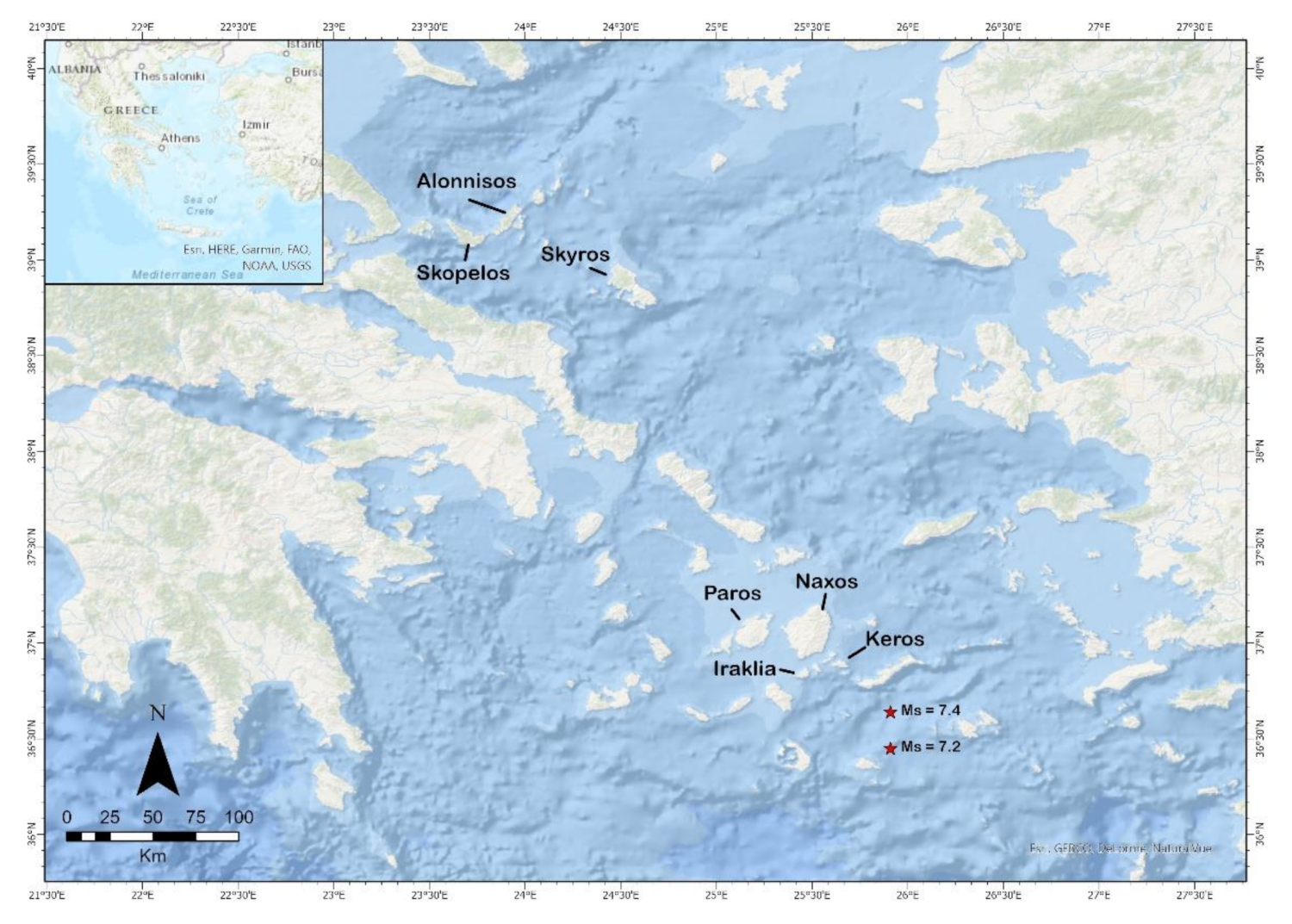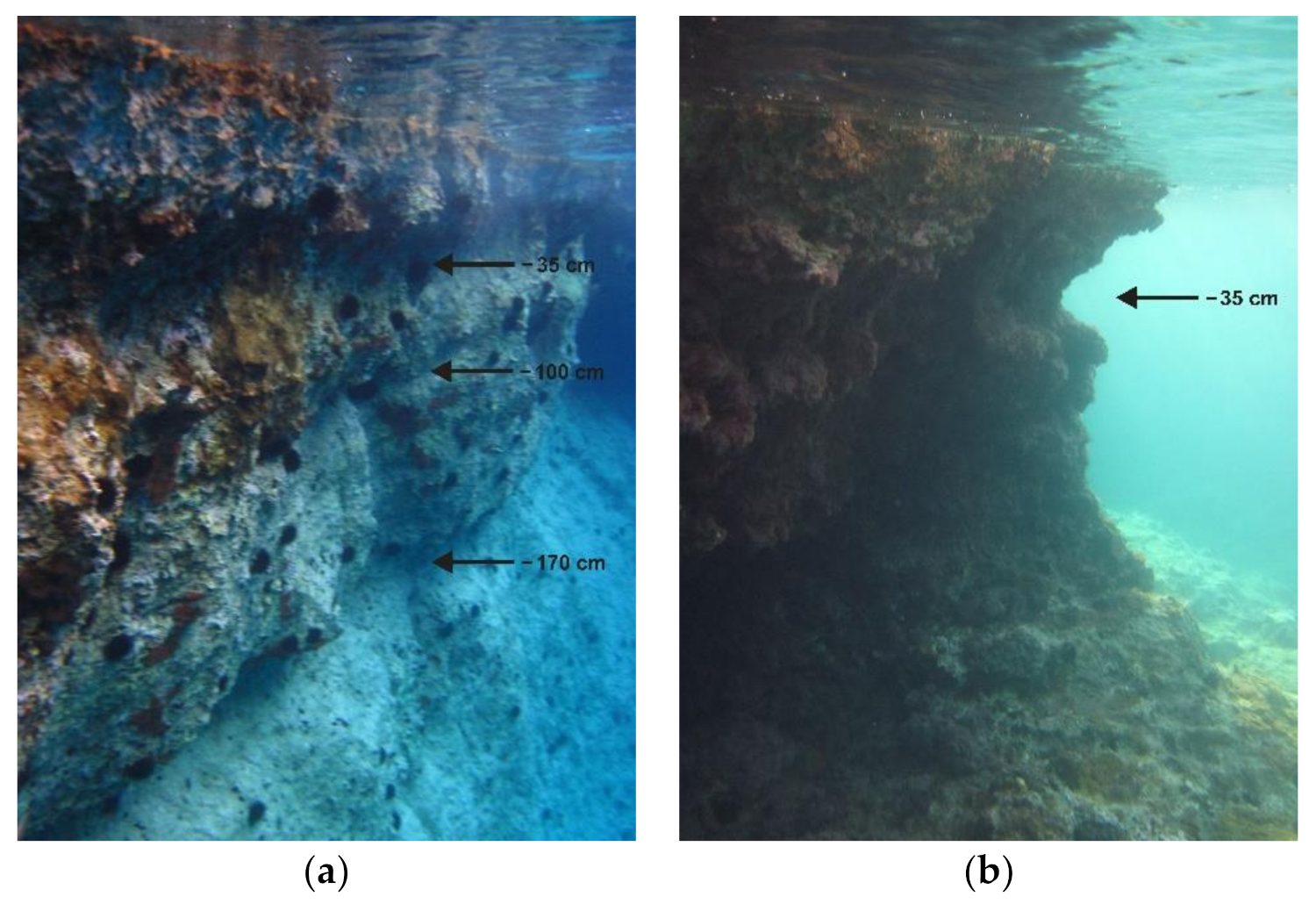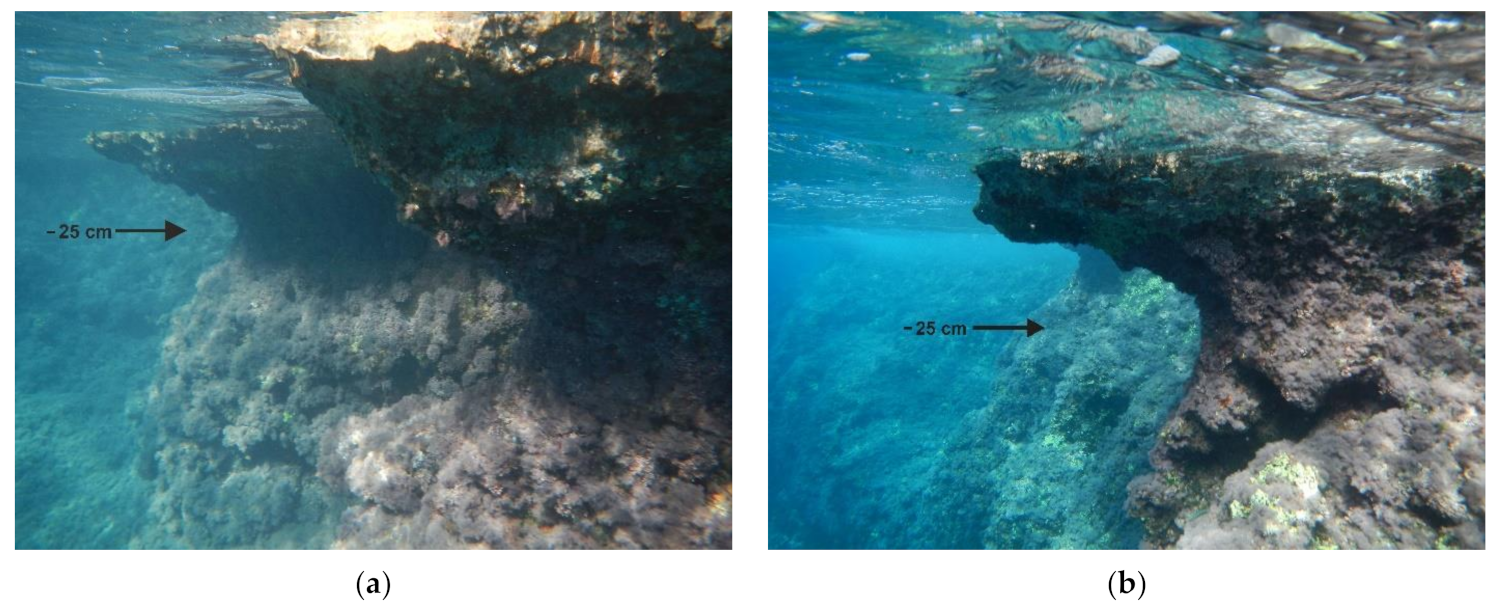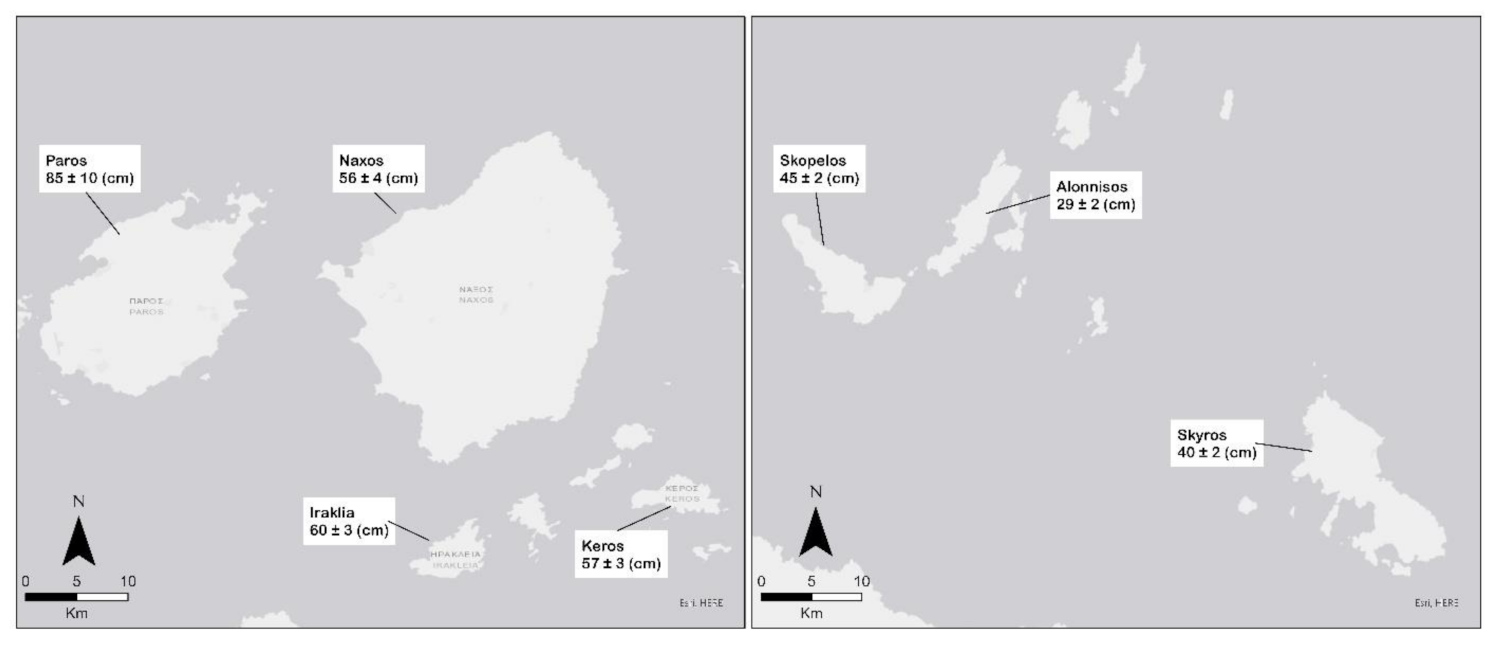Multiple Submerged Tidal Notches: A Witness of Sequences of Coseismic Subsidence in the Aegean Sea, Greece
Abstract
1. Introduction
2. What Is a Tidal Notch?
- Type a’ corresponds to a reclined U-shaped notch profile, with the roof height (HR) being very similar to the height of the floor (HF). The underwater preserved fossil notch owes its current position to a rapid subsidence, larger than the tidal range.
- Type b’ corresponds to two submerged fossil notches, owing their present location to two rapid subsidence events, larger than the tidal range.
- Type c’ corresponds to a rapid subsidence smaller than the tidal range. When the subsidence is preceded and followed by a relative sea-level stability, it results in a notch profile with a height greater than the tidal range and two vertices separated by an undulation, indicating the former and the following MSL positions.
- Type d’ corresponds to a notch profile much higher than the tidal range but with limited inward depth, which is owed to a gradual RSL rise, at a rate smaller than the bioerosion rate.
- Type e’ corresponds to a notch profile with the floor height (HF) larger than the roof height (HR), owing its formation to a gradual RSL rise, followed by relative sea-level stability.
- Type e’’ corresponds to a notch profile with the roof height (HR) larger than the floor height (HF), owing its formation to a RSL stability followed by a gradual RSL rise.
3. Case Studies
4. Results and Discussion
5. Conclusions
Author Contributions
Funding
Institutional Review Board Statement
Informed Consent Statement
Data Availability Statement
Acknowledgments
Conflicts of Interest
References
- Pirazzoli, P.A.; Thommeret, J.; Thommeret, Y.; Laborel, J.; Montag-Gioni, L.F. Crustal Block Movements from Holocene Shorelines: Crete and Antikythira (Greece). Tectonophysics 1982, 86, 27–43. [Google Scholar] [CrossRef]
- Pirazzoli, P.A.; Montaggioni, L.F.; Saliège, J.F.; Segonzac, G.; Thommeret, Y.; Vergnaud-Grazzini, C. Crustal Block Movements from Holocene Shorelines: Rhodes Island (Greece). Tectonophysics 1989, 170, 89–114. [Google Scholar] [CrossRef]
- Schneiderwind, S.; Boulton, S.J.; Papanikolaou, I.; Kázmér, M.; Reicherter, K. Numerical Modeling of Tidal Notch Sequences on Rocky Coasts of the Mediterranean Basin. J. Geophys. Res. Earth Surf. 2017, 122, 1154–1181. [Google Scholar] [CrossRef]
- Pirazzoli, P.A.; Stiros, S.C.; Arnold, M.; Laborel, J.; Laborel-Deguen, F.; Papageorgiou, S. Episodic Uplift Deduced from Holocene Shorelines in the Perachora Peninsula, Corinth Area, Greece. Tectonophysics 1994, 229, 201–209. [Google Scholar] [CrossRef]
- Bard, E.; Jouannic, C.; Hamelin, B.; Pirazzoli, P.; Arnold, M.; Faure, G.; Sumosusastro, P. Pleistocene Sea Levels and Tectonic Uplift Based on Dating of Corals from Sumba Island, Indonesia. Geophys. Res. Lett. 1996, 23, 1473–1476. [Google Scholar] [CrossRef]
- Stewart, I.S.; Cundy, A.; Kershaw, S.; Firth, C. Holocene Coastal Uplift in the Taormina Area, Northeastern Sicily: Implications for the Southern Prolongation of the Calabrian Seismogenic Belt. J. Geodyn. 1997, 24, 37–50. [Google Scholar] [CrossRef]
- Morhange, C.; Pirazzoli, P.A.; Marriner, N.; Montaggioni, L.F.; Nammour, T. Late Holocene Relative Sea-Level Changes in Lebanon, Eastern Mediterranean. Mar. Geol. 2006, 230, 99–114. [Google Scholar] [CrossRef]
- Stiros, S.C.; Pirazzoli, P.A.; Fontugne, M. New Evidence of Holocene Coastal Uplift in the Strophades Islets (W Hellenic Arc, Greece). Mar. Geol. 2009, 267, 207–211. [Google Scholar] [CrossRef]
- Vacchi, M.; Rovere, A.; Zouros, N.; Desruelles, S.; Caron, V.; Firpo, M. Spatial Distribution of Sea-Level Markers on Lesvos Island (NE Aegean Sea): Evidence of Differential Relative Sea-Level Changes and the Neotectonic Implications. Geomorphology 2012, 159, 50–62. [Google Scholar] [CrossRef]
- Boulton, S.J.; Stewart, I.S. Holocene Coastal Notches in the Mediterranean Region: Indicators of Palaeoseismic Clustering? Geomorphology 2015, 237, 29–37. [Google Scholar] [CrossRef]
- Sisma-Ventura, G.; Sivan, D.; Shtienberg, G.; Bialik, O.M.; Filin, S.; Greenbaum, N. Last Interglacial Sea Level High-Stand Deduced from Well-Preserved Abrasive Notches Exposed on the Galilee Coast of Northern Israel. Palaeogeogr. Palaeoclimatol. Palaeoecol. 2017, 470, 1–10. [Google Scholar] [CrossRef]
- Pirazzoli, P.A. Formes de corrosion marine et vestiges archéologiques submerges: Interprétation néotectonique de quelques exemples en Grèce et en Yougoslavie. Ann. l’ Inst. Oceanogr. 1980, 56, 101–111. [Google Scholar]
- Fouache, E.; Faivre, S.; Gluscevic, S.; Kovacic, V.; Tassaux, F. Evolution of the Croatian Shore Line between Porec and Split Over the Past 2000 Years. Archaeol. Marit. Mediterr. 2005, 2, 115–134. [Google Scholar]
- Benac, Č.; Juračić, M.; Bakran-Petricioli, T. Submerged Tidal Notches in the Rijeka Bay NE Adriatic Sea: Indicators of Relative Sea-Level Change and of Recent Tectonic Movements. Mar. Geol. 2004, 212, 21–33. [Google Scholar] [CrossRef]
- Benac, Č.; Juračić, M.; Blašković, I. Tidal Notches in Vinodol Channel and Bakar Bay, NE Adriatic Sea: Indicators of Recent Tectonics. Mar. Geol. 2008, 248, 151–160. [Google Scholar] [CrossRef]
- Antonioli, F.; Anzidei, M.; Lambeck, K.; Auriemma, R.; Gaddi, D.; Furlani, S.; Orrù, P.; Solinas, E.; Gaspari, A.; Karinja, S.; et al. Sea-Level Change During the Holocene in Sardinia and in the Northeastern Adriatic (Central Mediterranean Sea) from Archaeological and Geomorphological Data. Quat. Sci. Rev. 2007, 26, 2463–2486. [Google Scholar] [CrossRef]
- Nixon, F.C.; Reinhardt, E.G.; Rothaus, R. Foraminifera and Tidal Notches: Dating Neotectonic Events at Korphos, Greece. Mar. Geol. 2009, 257, 41–53. [Google Scholar] [CrossRef][Green Version]
- Faivre, S.; Fouache, E.; Kovačić, V.; Gluscevic, S. Geomorphological and Archaeological Indicators of Croatian Shoreline Evolution Over the Last Two Thousand Years. Geo. Acta. 2010, 3, 125–133. [Google Scholar]
- Furlani, S.; Cucchi, F.; Biolchi, S.; Odorico, R. Notches in the Northern Adriatic Sea: Genesis and Development. Quat. Int. 2011, 232, 158–168. [Google Scholar] [CrossRef]
- Faivre, S.; Butorac, V. Recently Submerged Tidal Notches in the Wider Makarska Area (Central Adriatic, Croatia). Quat. Int. 2018, 494, 225–235. [Google Scholar] [CrossRef]
- Evelpidou, N.; Vassilopoulos, A.; Pirazzoli, P. Submerged Notches on the Coast of Skyros Island (Greece) as Evidence for Holocene Subsidence. Geomorphology 2012, 141, 81–87. [Google Scholar] [CrossRef]
- Evelpidou, N.; Koutsomichou, I.; Pirazzoli, P. Evidence of Late Holocene Subsidence Events in Sporades Islands: Skopelos and Alonnisos. Cont. Shelf Res. 2013, 69, 31–37. [Google Scholar] [CrossRef]
- Evelpidou, N.; Melini, D.; Pirazzoli, P.A.; Vassilopoulos, A. Evidence of Repeated Late Holocene Rapid Subsidence in the SE Cyclades (Greece) Deduced from Submerged Notches. Int. J. Earth Sci. 2014, 103, 381–395. [Google Scholar] [CrossRef]
- Marriner, N.; Morhange, C.; Faivre, S.; Flaux, C.; Vacchi, M.; Miko, S.; Dumas, V.; Boetto, G.; Radic Rossi, I. Post-Roman Sea-Level Changes on Pag Island (Adriatic Sea): Dating Croatia’s “Enigmatic” Coastal Notch? Geomorphology 2014, 221, 83–94. [Google Scholar] [CrossRef]
- Evelpidou, N.; Pirazzoli, P.A. Holocene Relative Sea-Level Changes from Submerged Tidal Notches: A Methodological Approach. Quaternaire 2014, 25, 383–390. [Google Scholar] [CrossRef][Green Version]
- Stronge, W.B.; Diaz, H.F.; Bokuniewicz, H.; Inman, D.L.; Jenkins, S.A.; Hsu, J.R.C.; Kennish, M.J.; Bird, E.; Hesp, P.A.; Crowell, M.; et al. Erosion Processes. In Encyclopedia of Coastal Science; Schwartz, M.L., Ed.; Springer: Dordrecht, The Netherlands, 2005; pp. 432–433. ISBN 978–1−4020–3880−8. [Google Scholar]
- Trenhaile, A.S. Modelling Tidal Notch Formation by Wetting and Drying and Salt Weathering. Geomorphology 2014, 224, 139–151. [Google Scholar] [CrossRef]
- Pirazzoli, P.A. Marine Notches. In Sea-Level Research; Springer: Dordrecht, The Netherlands, 1986; pp. 361–400. [Google Scholar]
- Laborel, J.; Laborel-Deguen, F. Sea-Level Indicators, Biologic. In Encyclopedia of Coastal Science; Schwartz, M.L., Ed.; Springer: Dordrecht, The Netherlands, 2005; pp. 833–834. [Google Scholar]
- Schneider, J. Biological and Inorganic Factors in the Destruction of Limestone Coasts; Sadler, T.P., Ed.; Schweizerbart’sche Verlagsbuchhandlung: Stuttgart, Germany, 1976; ISBN 978–3−510–57006−5. [Google Scholar]
- Torunski, H. Biological Erosion and Its Significance for the Morphogenesis of Limestone Coasts and for Nearshore Sedimentation (Northern Adriatic). Senckenbergiana Marit. 1979, 11, 193–265. [Google Scholar]
- Spencer, T. Limestone Coastal Morphology. Prog. Phys. Geogr. Earth Environ. 1988, 12, 66–101. [Google Scholar] [CrossRef]
- Fairbridge, R.W. Marine Erosion. Proc. Seventh Pacific Sci. Congr. 1952, 3, 347–359. [Google Scholar]
- Hodgkin, E.P. Rate of Erosion of Intertidal Limestone. Z. Geomorphol. 1964, 8, 385–392. [Google Scholar]
- Moses, C.; Robinson, D.; Kazmer, M.; Williams, R. Towards an Improved Understanding of Erosion Rates and Tidal Notch Development on Limestone Coasts in the Tropics: 10 Years of Micro-Erosion Meter Measurements, Phang Nga Bay, Thailand. Earth Surf. Process. Landf. 2015, 40, 771–782. [Google Scholar] [CrossRef]
- Pirazzoli, P.; Evelpidou, N. Tidal Notches: A Sea-Level Indicator of Uncertain Archival Trustworthiness. Palaeogeogr. Palaeoclimatol. Palaeoecol. 2013, 369, 377–384. [Google Scholar] [CrossRef]
- Evelpidou, N.; Pirazzoli, P.A. Estimation of the Intertidal Bioerosion Rate from a Well-Dated Fossil Tidal Notch in Greece. Mar. Geol. 2016, 380, 191–195. [Google Scholar] [CrossRef]
- Blanc, J. Vitesse de formation des encoches littorales. Oceanis 1980, 5, 325–326. [Google Scholar]
- Furlani, S.; Cucchi, F. Downwearing Rates of Vertical Limestone Surfaces in the Intertidal Zone (Gulf of Trieste, Italy). Mar. Geol. 2013, 343, 92–98. [Google Scholar] [CrossRef]
- Furlani, S.; Cucchi, F.; Forti, F.; Rossi, A. Comparison between Coastal and Inland Karst Limestone Lowering Rates in the Northeastern Adriatic Region (Italy and Croatia). Geomorphology 2009, 104, 73–81. [Google Scholar] [CrossRef]
- Evelpidou, N.; Pirazzoli, P.; Vassilopoulos, A.; Tomasin, A. Holocene Submerged Shorelines on Theologos Area (Greece). Z. Geomorphol. 2011, 55, 31–44. [Google Scholar] [CrossRef]
- Evelpidou, N.; Kampolis, I.; Pirazzoli, P.A.; Vassilopoulos, A. Global Sea-Level Rise and the Disappearance of Tidal Notches. Glob. Planet. Chang. 2012, 92, 248–256. [Google Scholar] [CrossRef]
- Sakellariou, D.; Galanidou, N. Aegean Pleistocene Landscapes Above and Below Sea-Level: Palaeogeographic Reconstruction and Hominin Dispersals. In Under the Sea: Archaeology and Palaeolandscapes of the Continental Shelf; Springer: New York, NY, USA, 2017; pp. 335–359. ISBN 978. [Google Scholar]
- Flemming, N.C. Holocene Earth Movements and Eustatic Sea Level Change in the Peloponnese. Nature 1968, 217, 1031–1032. [Google Scholar] [CrossRef]
- Lambeck, K. Late Pleistocene and Holocene Sea-Level Change in Greece and South-Western Turkey: A Separation of Eustatic, Isostatic and Tectonic Contributions. Geophys. J. Int. 1995, 122, 1022–1044. [Google Scholar] [CrossRef]
- Perissoratis, C.; Conispoliatis, N. The Impacts of Sea-Level Changes During Latest Pleistocene and Holocene Times on the Morphology of the Ionian and Aegean Seas (SE Alpine Europe). Mar. Geol. 2003, 196, 145–156. [Google Scholar] [CrossRef]
- Sakellariou, D.; Galanidou, N. Pleistocene Submerged Landscapes and Palaeolithic Archaeology in the Tectonically Active Aegean Region. Geol. Soc. Lond. Spec. Publ. 2016, 411, 145–178. [Google Scholar] [CrossRef]
- Sakellariou, D.; Mascle, J.; Lykousis, V. Strike Slip Tectonics and Transtensional Deformation in the Aegean Region and the Hellenic Arc: Preliminary Results. Bull. Geol. Soc. Greece 2017, 47, 647–656. [Google Scholar] [CrossRef]
- Chelli, A.; Pappalardo, M.; Bini, M.; Brückner, H.; Neri, G.; Neri, M.; Spada, G. Assessing Tectonic Subsidence from Estimates of Holocene Relative Sea-Level Change: An Example from the NW Mediterranean (Magra Plain, Italy). Holocene 2017, 27, 1988–1999. [Google Scholar] [CrossRef]
- Melis, R.T.; Di Rita, F.; French, C.; Marriner, N.; Montis, F.; Serreli, G.; Sulas, F.; Vacchi, M. 8000 Years of Coastal Changes on A Western Mediterranean Island: A Multiproxy Approach from the Posada Plain of Sardinia. Mar. Geol. 2018, 403, 93–108. [Google Scholar] [CrossRef]
- Karkani, A.; Evelpidou, N.; Giaime, M.; Marriner, N.; Morhange, C.; Spada, G. Late Holocene Sea-Level Evolution of Paros Island (Cyclades, Greece). Quat. Int. 2019. [Google Scholar] [CrossRef]
- Pavlides, S.; Caputo, R. Magnitude Versus Faults’ Surface Parameters: Quantitative Relationships from the Aegean Region. Tectonophysics 2004, 380, 159–188. [Google Scholar] [CrossRef]
- Evelpidou, N.; Melini, D.; Pirazzoli, P.; Vassilopoulos, A. Evidence of A Recent Rapid Subsidence in the S–E Cyclades (Greece): An Effect of the 1956 Amorgos Earthquake? Cont. Shelf Res. 2012, 39, 27–40. [Google Scholar] [CrossRef]
- Vamvakaris, D.A.; Papazachos, C.B.; Papaioannou, C.A.; Scordilis, E.M.; Karakaisis, G.F. A Detailed Seismic Zonation Model for Shallow Earthquakes in the Broader Aegean Area. Nat. Hazards Earth Syst. Sci. 2016, 16, 55–84. [Google Scholar] [CrossRef]





| Locality | Measurement Method | Duration of Measurement or Geological Estimation | Erosion Rate (mm/a) | Reference |
|---|---|---|---|---|
| Cassis (Marseille) | Notch 0.5 m deep | 500 to 2000 years BP | 0.25 to 1.0 | [38] |
| Gulf of Trieste | MEM and TMEM | 5 years | 0.01 to 0.32 | [39] |
| Near Rovinj (Istria) | Supratidal rock pools | <2 years | 0.25 to1.0 | [30] |
| Istria N coast | 6 intertidal MEM stations | 2.5 years | 0.46 to1.11 | [31] |
| Istria W coast | 10 intertidal MEM stations | 2.3 years | 0.023 to 0.093 | [40] |
| Makarska, Central Adriatic | Notch 35 cm deep | 500 years | 0.7 | [20] |
| Antikythira, Greece | Fossil tidal notches 3–7 cm deep | 200–250 years | 0.2 to 0.3 | [1] |
| Skyros, Greece | 2 fossil tidal notches | Less than 710 years | Average: 0.8 | [21] |
| Cephalonia, Greece | Notch 0.93 cm deep | 1453 ± 100 years | 0.64 | [37] |
| Island | Shoreline | Depth below Present MSL (cm) | Number of Notches Measured | Average Inward Depth Notch Profile (cm) | Duration of Development for 0.64-mm/a Bioerosion Rate (Centuries) | Reference |
|---|---|---|---|---|---|---|
| Naxos | G | −35 ± 5 | 4 | 23 | 3.6 | [23], Table 2 |
| F | −75 ± 10 | 1 | 39 | 6.1 | [23], Table 2 | |
| E | −100 ± 10 | 2 | 33 | 5.2 | [23], Table 2 | |
| D | −120 ± 10 | 2 | 35 | 5.5 | [23], Table 2 | |
| A | −280 ± 20 | 1 | 60 | 9.4 | [23], Table 2 | |
| Total Naxos | −280 ± 20 | 29.7 | [23], Table 2 | |||
| Keros | G | −35 ± 5 | 4 | 15 | 2.3 | [23], Table 2 |
| E | −100 ± 10 | 1 | 15 | 2.3 | [23], Table 2 | |
| C | −170 ± 10 | 1 | 40 | 6.3 | [23], Table 2 | |
| Total Keros | −170 ± 10 | 10.9 | ||||
| Iraklia | G | −35 ± 5 | 3 | 13 | 2.0 | [23], Table 2 |
| E | −100 ± 10 | 1 | 15 | 2.3 | [23], Table 2 | |
| C | −180 ± 10 | 1 | 27 | 4.2 | [23], Table 2 | |
| B | −220 ± 10 | 1 | 23 | 3.6 | [23], Table 2 | |
| Total Iraklia | −220 ± 10 | 12.2 | ||||
| Paros | G | −35 ± 5 | 6 | 22 | 3.4 | [23], Table 2 |
| C | −170 ± 20 | 4 | 35 | 5.5 | [23], Table 2 | |
| Total Paros | −170 ± 20 | 8.9 | ||||
| Skopelos | A | −25 ± 11 | 6 | 25 | 3.9 | [22], Table 1 |
| B | −40 ± 11 | 1 | 17 | 2.7 | [22], Table 1 | |
| C | −55 ± 11 | 5 | 16 | 2.5 | [22], Table 1 | |
| D | −70 ± 11 | 1 | 25 | 3.9 | [22], Table 1 | |
| E | −100 ± 11 | 2 | 23 | 3.6 | [22], Table 1 | |
| F | −145 ± 11 | 2 | 22 | 3.4 | [22], Table 1 | |
| G | −270 ± 11 | 1 | 57 | 8.9 | [22], Table 1 | |
| Total Skopelos | −270 ± 11 | 28.9 | ||||
| Alonnisos | A | −25 ± 11 | 6 | 34 | 5.3 | [22], |
| B | −45 ± 11 | 4 | 26 | 4.1 | [22], | |
| C | −85 ± 11 | 2 | 16 | 2.5 | [22], | |
| D | −100 ± 11 | 2 | 47 | 7.3 | [22], | |
| E | −133 ± 11 | 3 | 28 | 4.4 | [22], | |
| F | −150 ± 11 | - | - | |||
| G | −175 ± 11 | 2 | 25 | 3.9 | [22], | |
| Total Alonnisos | −175 ± 11 | > 27.5 | ||||
| Skyros | A | −26 ± 10 | 11 | 26 | 4.1 | [21], Table 2 |
| B | −81 ± 10 | 6 | 30 | 5.0 | [21], Table 2 | |
| Total Skyros | −81 ± 10 | 9.1 |
| Island | Total Observed Subsidence (cm Below Present MSL) | No of Coseismic Subsidence Disclosed by Tidal Notches | Average Coseismic Subsidence (cm) | Average Coseismic Return Time (centuries) | Reference |
|---|---|---|---|---|---|
| Naxos | 280 ± 20 | 5 | 56 ± 4 | 5.9 | [23] |
| Keros | 170 ± 10 | 3 | 57 ± 3 | 3.6 | [23] |
| Iraklia | 180 ± 10 | 3 | 60 ± 3 | 3 | [23] |
| Paros | 170 ± 20 | 2 | 85 ± 10 | 4.5 | [23] |
| Skopelos | 270 ± 11 | 6 | 45 ± 2 | 4.1 | [22] |
| Alonnisos | 175 ± 11 | 6 | 29 ± 2 | 3.9 | [22] |
| Skyros | −81 ± 10 | 2 | 40 ± 2 | 4.5 | [21] |
Publisher’s Note: MDPI stays neutral with regard to jurisdictional claims in published maps and institutional affiliations. |
© 2021 by the authors. Licensee MDPI, Basel, Switzerland. This article is an open access article distributed under the terms and conditions of the Creative Commons Attribution (CC BY) license (https://creativecommons.org/licenses/by/4.0/).
Share and Cite
Karkani, A.; Evelpidou, N. Multiple Submerged Tidal Notches: A Witness of Sequences of Coseismic Subsidence in the Aegean Sea, Greece. J. Mar. Sci. Eng. 2021, 9, 426. https://doi.org/10.3390/jmse9040426
Karkani A, Evelpidou N. Multiple Submerged Tidal Notches: A Witness of Sequences of Coseismic Subsidence in the Aegean Sea, Greece. Journal of Marine Science and Engineering. 2021; 9(4):426. https://doi.org/10.3390/jmse9040426
Chicago/Turabian StyleKarkani, Anna, and Niki Evelpidou. 2021. "Multiple Submerged Tidal Notches: A Witness of Sequences of Coseismic Subsidence in the Aegean Sea, Greece" Journal of Marine Science and Engineering 9, no. 4: 426. https://doi.org/10.3390/jmse9040426
APA StyleKarkani, A., & Evelpidou, N. (2021). Multiple Submerged Tidal Notches: A Witness of Sequences of Coseismic Subsidence in the Aegean Sea, Greece. Journal of Marine Science and Engineering, 9(4), 426. https://doi.org/10.3390/jmse9040426







